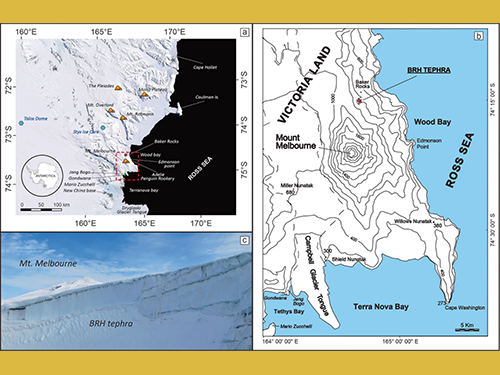Historical explosive activity of Mount Melbourne Volcanic Field (Antarctica) revealed by englacial tephra deposits

Del Carlo P., A. Di Roberto, G. Re, P.G. Albert, V.C. Smith, G. Giudice, G. Larocca, B. Scateni, A. Cannata (2023).
Bulletin of Volcanology, 85, 39. https://doi.org/10.1007/s00445-023-01651-2
Abstract
Five tephra layers named BRH1 to 5 were sampled in an ice cliff located on the north-eastern flank of Mount Melbourne (northern Victoria Land, Antarctica). The texture, componentry, mineralogy, and major and trace element compositions of glass shards have been used to characterize these layers. These properties suggest that they are primary fall deposits produced from discrete eruptions that experienced varying degrees of magma/water interaction. The major and trace element glass shard analyses on single glass shards indicate that Mount Melbourne Volcanic Field is the source of these tephra layers and the geochemical diversity highlights that the eruptions were fed by compositionally diverse melts that are interpreted to be from a complex magma system with a mafic melt remobilizing more evolved trachy-andesitic to trachytic magma pockets. Geochemical compositions, along with textural and mineralogical data, have allowed correlations between two of the englacial tephra and distal cryptotephra from Mount Melbourne, recovered within a marine sediment core in the Edisto Inlet (~ 280 km northeast of Mount Melbourne), and constrain the age of these englacial tephra layers to between the third and the fourth century CE. This work provides new evidence of the intense historical explosive activity of the Mount Melbourne Volcanic Field and better constrains the rates of volcanism in northern Victoria Land. These data grant new clues on the eruptive dynamics and tephra dispersal, and considerably expand the geochemical (major and trace elements) dataset available for the Mount Melbourne Volcanic Field. In the future, this will facilitate the precise identification of tephra layers from this volcanic source and will help define the temporal and spatial correlation between Antarctic records using tephra layers. Finally, this work also yields new valuable time-stratigraphic marker horizons for future dating, synchronization, and correlations of different palaeoenvironmental and palaeoclimatic records across large regions of Antarctica.


Devi effettuare l'accesso per postare un commento.